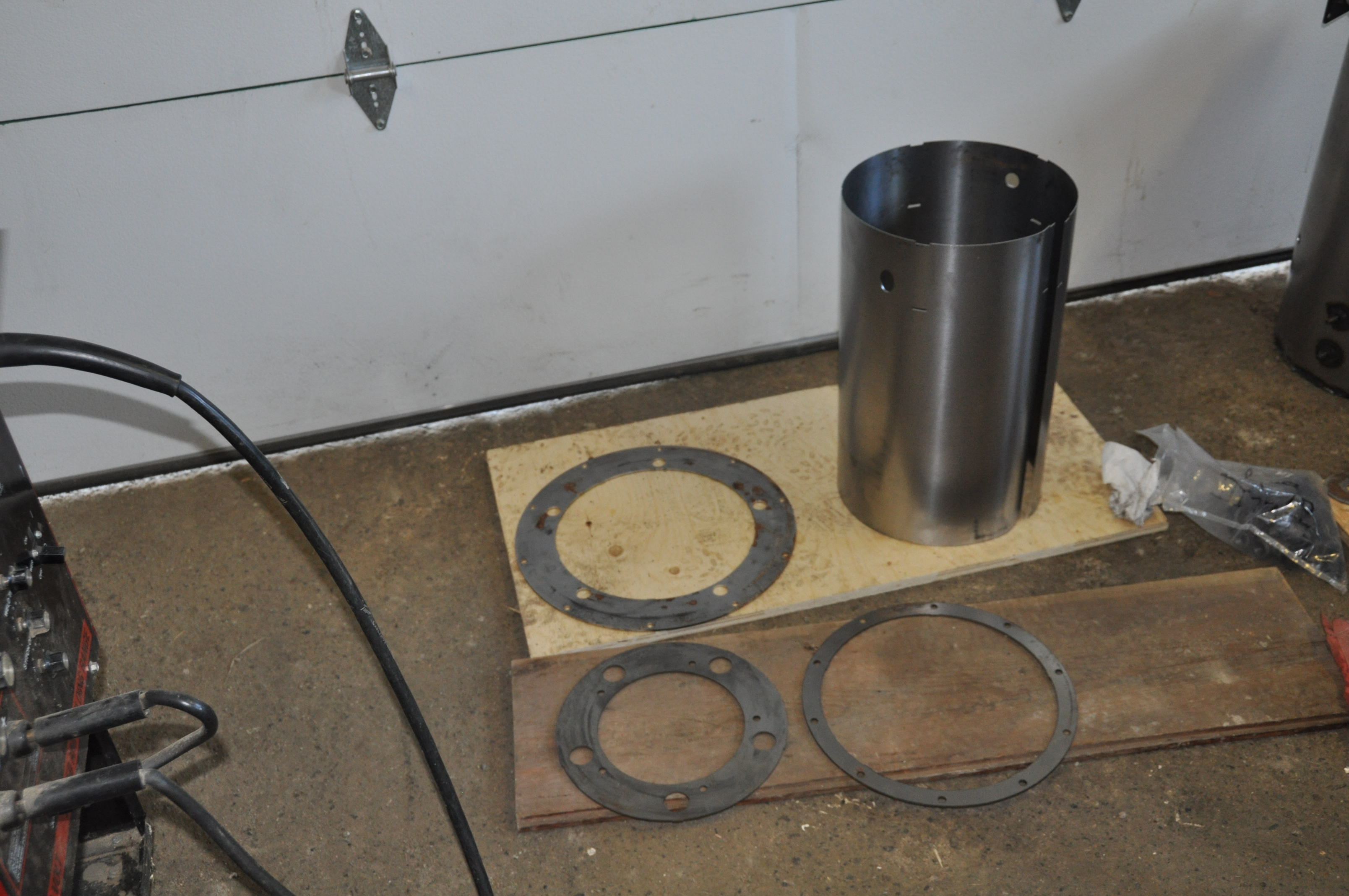
Over the last 3 days I have been building here and there when I have had time …
I did get a response back from Julia Hasty at All Power Labs answering my questions raised in the last post. I have added her response to these questions as a comment to that post … thanks Julia! In the interim I decided to leave the parts I had questions with and carry on.
The first thing I did was to weld the three assemblies (ash port, grate shake port and gas out)to the gas cowling. This work seemed to go well, and after I was done I set aside the gas cowling.
I then started working on the reactor … first thing I did was to watch the video from All Power Labs about fabricating the reactor. This is a long video and I am guessing that welding the reactor together is
probably the biggest job in this project … I’ll know if I was right when I am done! I started by tack welding the middle top and bottom flanges. This step was similar to work done previously … I worked to 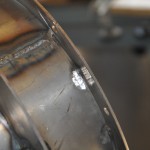 make sure that the flanges and the sheet metal sides fit together as tightly as possible … lots of clamping.
make sure that the flanges and the sheet metal sides fit together as tightly as possible … lots of clamping.
In the video you are warned to use small tack welds on the underside of the top flange … I obviously did not appreciate how small these tack welds needed to be! I ended up having to grind all but one of these tacks back to accommodate the air neck … listen to the video and use small tack welds for the top flange!
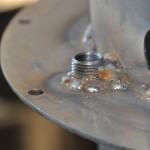 Once the three flanges were tacked all of the seams were welded air tight except for the top flange. I found welding the gas line connectors to the mid flange a little challenging … they are to be welded air tight but there is not a lot of space for the welding gun between a connector and the reactor wall. I found my technique improved with each connector.
Once the three flanges were tacked all of the seams were welded air tight except for the top flange. I found welding the gas line connectors to the mid flange a little challenging … they are to be welded air tight but there is not a lot of space for the welding gun between a connector and the reactor wall. I found my technique improved with each connector.
After the connectors the air neck was tacked into place. The video seems to be out of synch with the
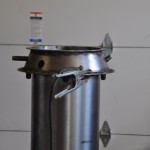 actual parts provided at this point … the video shows two smaller holes in the air neck being lined up with matching holes in the reactor wall with matching 1″ pipes welded (air tight) into these holes. The holes are not identical … one set of holes is as shown and the other set is for a pipe inserted on a 45 degree angle. I did not have the 1″ pipes shown in the video … I used the provided threaded nipples (one of these was cut on a 45 degree angle). The different parts that I used seemed to be the only obvious choice in this case. The seams of the air neck were welded air tight. The seem between the wall, bottom of the upper flange and the air neck was tough … you need to weld all three surfaces and getting good heat penetration on the wall was tough … again the gun nozzle was big for the small space … I am least happy with this weld but I think I got it to work. A 1″ weld coupling was then welded air tight to the air neck.
actual parts provided at this point … the video shows two smaller holes in the air neck being lined up with matching holes in the reactor wall with matching 1″ pipes welded (air tight) into these holes. The holes are not identical … one set of holes is as shown and the other set is for a pipe inserted on a 45 degree angle. I did not have the 1″ pipes shown in the video … I used the provided threaded nipples (one of these was cut on a 45 degree angle). The different parts that I used seemed to be the only obvious choice in this case. The seams of the air neck were welded air tight. The seem between the wall, bottom of the upper flange and the air neck was tough … you need to weld all three surfaces and getting good heat penetration on the wall was tough … again the gun nozzle was big for the small space … I am least happy with this weld but I think I got it to work. A 1″ weld coupling was then welded air tight to the air neck.
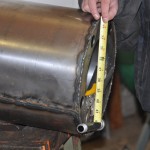 I then welded the 1/2″ 90 degree elbows into the larger holes in the bottom flange. The directions in the
I then welded the 1/2″ 90 degree elbows into the larger holes in the bottom flange. The directions in the
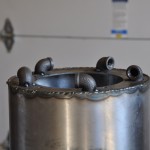
video worked well. I scribed my straight lines up the inside walls of the reactor from the centre line of these holes by using a plumb bob … I was not sure how else to do it. I did not enjoy welding in the space under the end of the elbow that was raised 1/8″ above the surface of the flange; it was a lot of welding, I think my gap between the elbow and the flange surface was a little too big and I am sure better technique would have helped! I experienced a lot of spatter while filling in and I thing I got a drop of weld on my laptop screen … no serious damage but the laptop will now be farther from my work area! It has been really useful to refer to the videos while working … but probably not worth the laptop.
I then was going to start work on the hourglass hearth. I started by tracking down parts, but after about an hour of looking (trying to be thorough) I was unable to find the hearth base flange. I ended up watching all of the remaining fabrication videos at this point so that I could match parts to assembled components, and I still could not find a part that looked like the hearth base flange. It also looks like I may be missing the grate support ledge lollipop (I want to check again tomorrow about this part as I was really trying to track down the hearth flange while watching this video.
I am impressed so far with this kit; the videos are well explained and the cut parts have fitted together well. I think I have done most of the welding at this point and am starting to think about painting.
Questions to this point that I need to resolve:
- The holes in the air neck that match up to holes in the reactor walls are not as shown in the video. The pipes that go into these holes are also not as shown. I am assuming that two threaded nipples are used here instead (one of them cut at 45 degrees)?
- Has the base flange for the hourglass hearth changed in appearance since the last video? I do not think it has but what do I do if I think it is missing?
- The other thing I realized watching the rest of the videos is I will be welding some stainless parts. I have not welded stainless before; I know you want to be well ventilated as the fumes are nasty, and I think you need special wire for stainless. I am going to read about differences welding stainless as opposed to welding typical steel. What do I need to be thinking about?
I finished off the day today by welding the brake line seams of the rocket legs. These legs seemed quite strong to me even without welding the seems, but regardless it is now done.
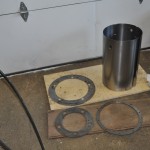
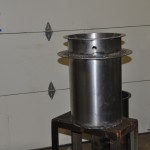
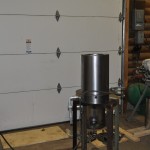
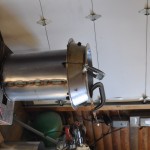
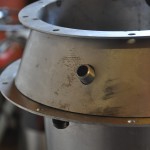
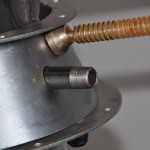
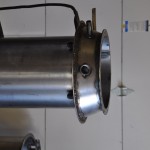
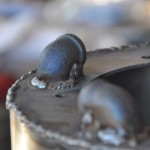
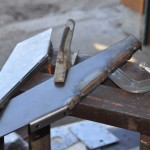
As for my last post about building the gasifier Julia Hasty from All Power labs has answered my questions … from Julia’s email:
I have just updated the instructions for the Level III here: http://wiki.gekgasifier.com/w/page/52196806/GEK%20v4x%20Fabrication%20Instructions
You will find the call outs specific to your latest version that might answer some of the subtle differences you are noticing.
As far as the stainless welding, the only thing stainless that you will be needing to weld is the hourglass reduction bell. If you get in a pinch we’ve been successful just welding with the same wire for the mild steel. Its not typically suggested as the absolute correct way to do things, but it has worked just find in the past for us. You will want ventilation for the stainless for sure, but since it is just for this part, you won’t have too much of it to do. While we offer the GEK IV in all stainless now, we are still providing the Level III in mild because of this concern that people have with doing a lot of welding with stainless.
Thanks again Julia